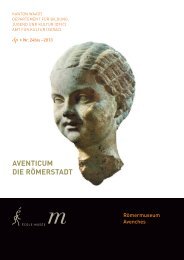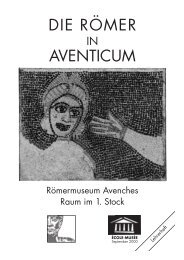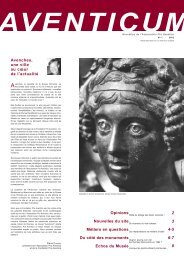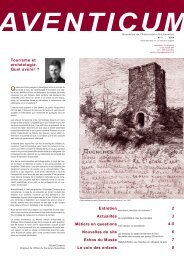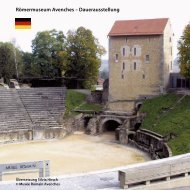Avenches – Roman Museum – Permanent Exhibition
Avenches – Roman Museum – Permanent Exhibition
Avenches – Roman Museum – Permanent Exhibition
You also want an ePaper? Increase the reach of your titles
YUMPU automatically turns print PDFs into web optimized ePapers that Google loves.
First Floor Language and Writing<br />
Nevertheless, Celtic culture and traditions survived. The Celtic heritage is apparent<br />
in art (display case 3, no. 1; display case 5, nos. 1-2), religion, writing, craftsmanship<br />
(display case 5, nos. 3-6), hairstyles and clothing (display case 3, no. 1).<br />
Display case 3<br />
1. Bust of woman (1) wearing a torque, a typical Celtic piece of jewellery, as well as a tunic<br />
and a cloak fashionable among the native population. Limestone. Early 1st century AD at<br />
the latest.<br />
Display case 4<br />
1. Dedication in honour of Caius Valerius Camillus:<br />
C(aio) Valer(io) C(ai) f(ilio) Fab(ia)Ca<br />
millo quoi publice<br />
funus Haeduorum<br />
civitas et Helvet(i)decre<br />
verunt et civitas<br />
Helvet(iorum)<br />
qua pagatim qua publice<br />
statuas decrevit<br />
I[u]lia C(ai)Iuli Camilli f(ilia) Festilla<br />
ex testamento<br />
« To Caius Valerius Camillus, son of Caius, of the Fabia tribe, for whom the communities<br />
of the Haedui and Helvetii ordered an official funeral; furthermore, the community of the<br />
Helvetii dedicated statues to him, in the name of each pagus as well as in the name of<br />
the entire civitas. Iulia Festilla, daughter of Caius Iulius Camillus, (erected this inscription)<br />
according to the last will of the deceased »<br />
Marble block, discovered near the forum. Second quarter of the 1st century AD.<br />
Catalogue of inscriptions: no. 5.<br />
Display case 5<br />
1. Head of woman, limestone. Cigognier sanctuary. Second half of the 2nd century AD.<br />
2. Gilt bronze head of a dead Helvetian (2). Cigognier sanctuary. 2nd century AD.<br />
3. Ceramic pot, painted according to local tradition.<br />
4-5. Ceramic goblets, with figurative decoration. Second half of the 2nd century AD.<br />
6. Ceramic goblet with erotic scene. Second half of the 2nd century AD.<br />
Language and Writing<br />
(Display case 6)<br />
The Helvetii spoke Gaulish, a Celtic language, which probably varied from one region<br />
of Gaul to the next. It was mainly a spoken language. The rare evidence at our<br />
disposal consists of written documents of lesser importance, which offer only limited<br />
information about Celtic culture. In the beginning, the Celts used Greek letters to<br />
transcribe their language. The arrival of the <strong>Roman</strong>s led to the dissemination of Latin,<br />
a new language, which, depending on the density of the <strong>Roman</strong> immigrants, was<br />
more or less understood and adopted.<br />
1<br />
2<br />
23<br />
First Floor<br />
3<br />
4<br />
5<br />
6



